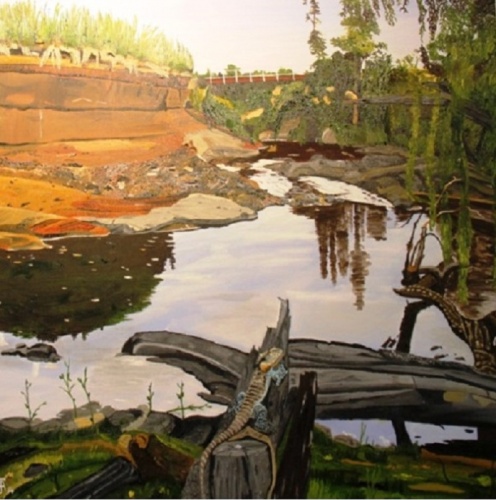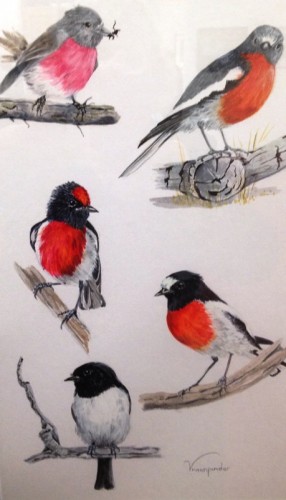WITH the chosen theme of “Connecting with Our Natural Landscape and Cultural Heritage,” the 11th year of the “Along the Molonglo” exhibition kicked off last night at the Canberra Grammar School Gallery.
2014 marks just over a decade of collaboration between the Molonglo Catchment Group (MCG) and the Artists Society of Canberra (ASOC). But it also represents the second year of collaboration with the two other catchment groups, the Ginninderra and Southern ACT Catchment Groups, so the exhibition has been retitled “The ACT Region Catchment Groups Art Exhibition.”
With 50 new paintings on display, it was evident that members of ASOC, Canberra’s oldest art society, had participated enthusiastically and this year, as well, the winner of the $2,000 ACTEW Water Prize for the best in show prize was none other than Dr Alan J. Jones, the society’s president, whose impression of an unusual angle of Scrivener Dam drew praise from the judge, Jo Hollier.
Dr Jones told “Citynews” that it was a bit of a climb to get the angle he wanted but that you wouldn’t want to do it when the water was rising.
He added that ASOC members achieves their artistic objectives through the exhibition and sale of their themed artwork. As well, the Catchment Groups, who funded the prizes, enhance the exhibition with a display of posters and brochures that invite people to participate in environmental protection field-work.
He said that the combined objective was to raise awareness of the work undertaken by all of the Catchment Groups to improve sustainability, conserve the natural environment and cultural heritage of the area.
This year’s theme, he said, was all about “connecting”. What the catchment groups would like to see is the artists connecting with the natural environment and cultural heritage of the ACT Region; recording perceptions of the landscapes and the human communities in those landscapes, the changes – disconnecting and reconnecting – to encourage the viewer to come closer to an understanding of their place in the landscape.
All the Catchment Groups, he noted, were working on reconnecting the fragmented natural landscape in the region by establishing habitat corridors across built-up areas and farmland. Lessons could also be learned from the culture of the traditional owners who cared for the land and understood the needs of birds and animals during their seasonal migration from the mountains to the coast.
This year, as well as having a theme, the exhibition has an emblem, Scarlet Robin, represented in beautiful impressions of the bird by Viv Pinder.
The full list of winners is as follows:
- The $600 Molonglo Catchment Art Prize went to “Sediment, Silt, Sand and Erosion,” by David Hatton.
- The $300 Southern Catchment Group Art Prize went to “Murrumbidgee Morning,” by Mark Redzic.
- The $200 Ginninderra Catchment Group Art Prize went to “wetlands,” by Noelle Bell.
- The $200 voucher Pepe’s Paperie Award went to “Darter Hanging out,” by Arlene Williams, The $2000 ACTEW Water Prize for Best in Show went to “Below Scrivener Dam,” by Alan J. Jones.
The Catchment Groups Art Prizes Exhibition, part of the ACT Heritage Festival, in The Gallery, Canberra [Boys’] Grammar School, 40 Monaro Crescent, Red Hill, 10am to 5pm daily, until Sunday, April 13.
The post River system celebrated in art appeared first on Canberra CityNews.


